
The Basilica of St. Francis Xavier is a parish church in the Archdiocese of Dubuque located in Dyersville, Iowa, United States. The church was named in honor of the missionary Saint Francis Xavier. It was raised to the status of a minor basilica in 1956. The church and rectory were listed together on the National Register of Historic Places in 1999.

St. Raphael's Cathedral is a Catholic cathedral and a parish church in the Archdiocese of Dubuque located in Dubuque, Iowa. The parish is the oldest congregation of any Christian denomination in the state of Iowa. The cathedral church, rectory, former convent, and former parochial school building are a contributing properties in the Cathedral Historic District on the National Register of Historic Places.

Sacred Heart Cathedral, located in Davenport, Iowa, United States, is a Catholic cathedral and a parish church in the Diocese of Davenport. The cathedral is located on a bluff overlooking the Mississippi River to the east of Downtown Davenport. It is listed on the National Register of Historic Places as part of the Sacred Heart Roman Catholic Cathedral Complex. This designation includes the church building, rectory, and the former convent, which was torn down in 2012. The cathedral is adjacent to the Cork Hill Historic District, also on the National Register. Its location on Cork Hill, a section of the city settled by Irish immigrants.

Brophy College Preparatory is a Jesuit high school in Phoenix, Arizona, United States founded in 1928. The school has an all-male enrollment of approximately 1,400 students. It is operated independently of the Roman Catholic Diocese of Phoenix.

St. Ambrose Cathedral is a historic building located in downtown Des Moines, Iowa, United States. It serves as a parish church and as the seat of the Diocese of Des Moines in the Catholic Church. The cathedral, along with the adjoining rectory, was listed on the National Register of Historic Places in 1979.

The Basilica of St. John is a Minor Basilica of the Catholic Church in the Drake neighborhood of Des Moines, Iowa, United States. It is also a parish church in the Diocese of Des Moines. The church building is listed on the National Register of Historic Places.
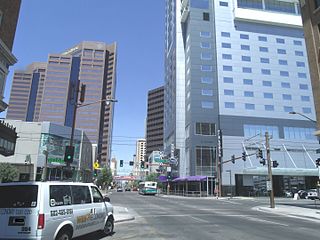
The Central Avenue Corridor is a significant stretch of north–south Central Avenue in Phoenix, Arizona. Roughly bounded by Camelback Road to its north, and McDowell Road to its south, this is one of Phoenix's most vital and heavily trafficked stretches of roads. It is also one of the region's largest centers of employment, with nearly 60,000 people being employed within a three-mile (5 km) radius of this swath of Central Avenue. Major employers here include major banks and financial institutions, hi-tech companies, and several significant law firms and government agencies.
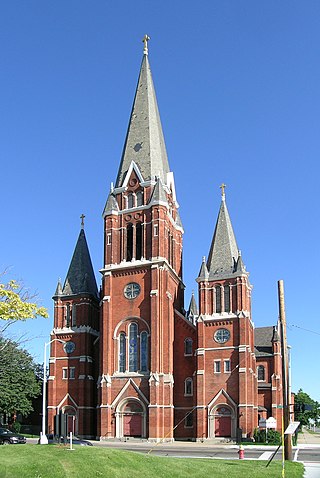
St. Josaphat Roman Catholic Church is a Roman Catholic church located at 715 East Canfield Street in Detroit, Michigan. It was listed on the National Register of Historic Places in 1982 and designated a Michigan State Historic Site in 1985. Since 2013, it has been one of two churches that comprise Mother of Divine Mercy Parish.

St. Henry's Catholic Church is an historic Roman Catholic church in St. Henry, Ohio, United States. Built in the late nineteenth century, it remains the home of a functioning congregation, and it has been recognized as a historically significant building because of its architecture.

The Church of All Saints is a parish of the Catholic Church in the Diocese of Davenport. The church is located in Keokuk, Iowa, United States. The church building is listed on the National Register of Historic Places as St. Peter Church, the name of the congregation that built it.

St. Joseph Catholic Church is a former Catholic parish in the Diocese of Davenport. Its former parish church is located in the west end of Davenport, Iowa, United States. It was listed on the National Register of Historic Places in 1983. The church and the rectory were listed together on the Davenport Register of Historic Properties in 1999. After serving as the location of a Reformed Baptist congregation and a private elementary school named Marquette Academy, the parish property now houses a fundamentalist Christian ministry named One Eighty.

St. Aloysius Catholic Church is a historic Roman Catholic church in Carthagena, an unincorporated community in Marion Township, Mercer County, Ohio, United States. Built in the late nineteenth century, it remains the home of an active parish, and it has been designated a historic site because of its well-preserved architecture.

Saints Peter and Paul Catholic Church is a parish church in the Archdiocese of Dubuque. The church is located in the unincorporated community of Petersburg, Iowa, United States. It was listed on the National Register of Historic Places in 1995.
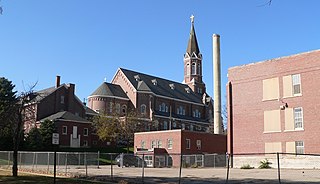
St. Boniface Catholic Church is a parish of the Diocese of Sioux City. The church is located in a residential area west of downtown Sioux City, Iowa, United States. The parish buildings form a nationally recognized historic district that was listed on the National Register of Historic Places in 1998 as St. Boniface Historic District. At the time of its nomination it contained three resources, all of them contributing buildings.

St. Benedict Cathedral is a Roman Catholic cathedral in Evansville, Indiana, United States. It is the seat of the Diocese of Evansville. The cathedral, rectory and original school building are contributing properties in the Lincolnshire Historic District on the National Register of Historic Places.

St. Peter's Roman Catholic Church is a Neogothic-styled church built in 1901 in the small farming community of Ashton, Wisconsin in the town of Springfield, Dane County, Wisconsin. It was added to the National Register of Historic Places in 1980.

Old St. Mary's Church – formerly Our Lady of Mount Carmel Catholic Church, and also known as "The Old Church: – at 230 East University Avenue in Tempe, Arizona, is a historic church at the built in 1903 and designed in the Romanesque Revival style by Father Severin Westhoff. It is the longest standing church in the Phoenix metropolitan area and served as a Catholic parish for the Tempe area until 1968, when it became home to the Arizona State University Newman Center. It currently serves as home to Mary College at ASU, a center for Catholic Studies formed in partnership between the University of Mary and Arizona State University, the Diocese of Phoenix, and the All Saints Catholic Newman Center. The Newman Center's offices and chapel stand adjacent to the historic church.
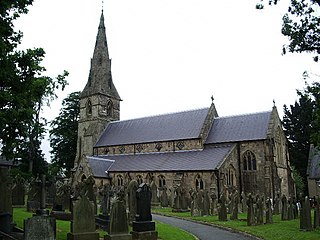
St John the Evangelist's Church is in Ribby Road, Kirkham, Lancashire, England. It is an active Roman Catholic parish church in the diocese of Lancaster. The church was designed by A. W. N. Pugin, and is recorded in the National Heritage List for England as a designated Grade II listed building.

The Church of St. John the Baptist is an historic church building located in Burlington, Iowa, United States. Together with St. Paul's Church in Burlington and St Mary's Church in West Burlington it forms Divine Mercy parish, which is a part of the Diocese of Davenport. The parish maintains the former parish church buildings as worship sites. St. John's was listed on the National Register of Historic Places in 1982.
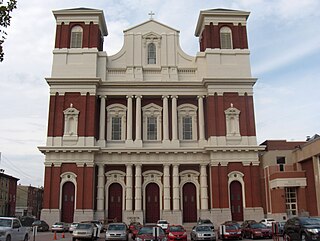
The Church of the Gesú is a Roman Catholic chapel and former parish church located in Philadelphia, Pennsylvania. Founded in 1868 by Burchard Villiger, the church was the center of several Jesuit educational institutions, including St. Joseph's Preparatory School, St. Joseph's University, and the Gesú School. The Baroque revival church was named after and loosely modeled after the Church of the Gesú in Rome. The parish closed in 1993, and the building became the chapel of St. Joseph's Prep. The church is part of the Girard Avenue Historic District.

























